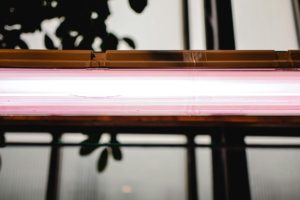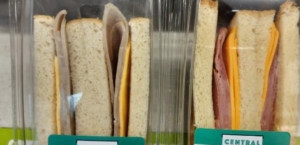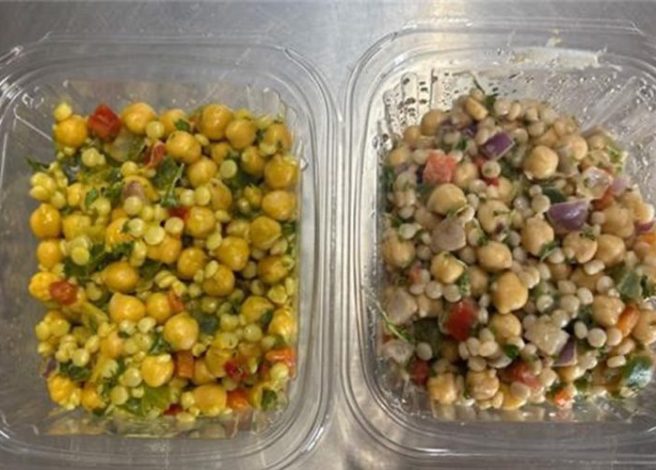Listen to the audio recording of this blog post or check out the featured Podcast about this topic.
At a Glance
- UV light exposure can damage food quality, causing oxidation, nutrient loss, color fading, and flavor changes.
- UV-blocking films and coatings protect freshness and extend shelf life.
- Materials like PET offer partial protection, but additives improve UV defense.
- Choosing the right barrier means balancing protection, clarity, recyclability, and compliance.
You just got a shipment of premium ribeye steaks. They are perfectly marbled and a rich ruby red. Show them in your fridge case with bright lights, and customers will see them right away. In a day or two, those steaks become an unappealing gray-brown. However, they are still safe to eat before the sell-by date. Does this sound familiar? What’s going on here? You’ve always thought of the science of meat packaging as “a rare medium well done.” (Wasn’t that fun?)
The answer isn’t always straightforward. The discoloration can also result from the packaging medium itself. For instance, vacuum-sealed steaks often lose their red hue due to the lack of oxygen. But once re-exposed to air, their color can bounce back as oxygen is reabsorbed into the muscle tissue. In open or high-oxygen modified atmosphere packaging, UV light from store lights can hurt the appearance. This damage can lead to lower sales.
You’re not alone in this frustrating scenario. Many food retailers and processors face the same challenge every day. They see their high-quality products lose appeal and value right before their eyes. The culprit? An invisible enemy that’s been hiding in plain sight: ultraviolet (UV) light.
Let’s shine a (non-UV) light on this persistent problem…
An Intro to UV Light
This week, we talked to a plastic sheet expert at a top polyester company to understand this issue better. He explained that fluorescent lighting makes food displays stand out. But it can also lead to product degradation. These lights give off some UV radiation. It’s a small amount, but it can affect appearance and freshness over time. Packaging methods also matter. Vacuum sealing, modified atmosphere, and preservatives all play a role, too. Still, UV exposure remains an often-overlooked contributor to the problem.
Even though vacuum-sealed packages remove oxygen — reducing some types of discoloration — they’re not immune to UV light. Without oxygen, color changes happen for different reasons, but UV exposure can still degrade surface quality, cause pigment breakdown, and affect appearance. In other words, vacuum sealing may limit some damage, but it doesn’t block UV’s harmful effects on fresh meat.
In this article, we’ll show how UV light may be hurting your profits. We’ll explain the science behind the damage. Plus, we’ll offer proven ways to protect your fresh food products and keep them looking great for sales.
The Problem: UV Light is Costing You Money
 Fluorescent light has a range of wavelengths, and part of that spectrum includes UV light. UV light changes more than just how food looks. It can contribute to rancidity and discoloration and breaks down important vitamins and minerals in food.
Fluorescent light has a range of wavelengths, and part of that spectrum includes UV light. UV light changes more than just how food looks. It can contribute to rancidity and discoloration and breaks down important vitamins and minerals in food.
The Real Cost of UV Damage
The financial impact extends far beyond cosmetic issues:
- Reduced shelf life leads to increased waste
- Decreased customer appeal, results in lost sales
- Compromised nutritional value potentially affects regulatory compliance
- Increased spoilage costs eat into your profit margins
High fat (lipid) content and UV light can lead to discoloration and spoilage in fresh meat. This can occur due to the following mechanisms:
- Fat oxidation: UV light speeds up lipid oxidation. This is especially true for fatty meats. This process produces peroxides and other oxidative compounds, which can cause rancid flavors and spoilage.
- Pigment degradation: UV light affects myoglobin, the pigment responsible for meat’s red color. When myoglobin oxidizes, it turns into deoxymyoglobin. This change gives the meat a brownish or greyish color, showing discoloration.
- Nutritional deterioration: UV light breaks down fat-soluble vitamins, such as A and E. This leads to lower meat quality.
- Microbial effects: UV light lowers surface microbes, but it also causes oxidative stress. This stress can help spoilage bacteria grow, as they thrive in oxidized conditions.
The Science Behind the Damage of UV Light on Fresh Food
It’s time to put on our science hats.
UV light operates on different wavelengths, each causing specific types of damage:
- UVA light (320-400 nanometers) penetrates packaging and directly affects food quality.
- UVB light (280-320 nanometers) breaks down vitamins and nutrients.
- UVC light (200-280 nanometers) is commonly used for sanitization. However, it can be harmful in retail settings.
When UV light hits your packaged foods, it doesn’t just cause surface-level problems. The energy penetrates the product, triggering chemical reactions that:
- Oxidize fats, leading to rancidity and off-flavors
- Break down proteins, causing texture changes
- Destroy vitamins A, C, and E
- Alter color compounds, making products appear old or spoiled
Our specialist highlights that meat products are particularly vulnerable. “Fresh meat shows a clear difference. The side exposed to UV light turns gray. But the protected side stays pink. It’s quite dramatic.” You can see a real-world example below:

Your Guide to UV Protection Solutions
The good news is that you don’t have to accept UV damage as an inevitable cost of doing business. You can use a few effective ways to protect your products. This keeps them looking great for customers.
UV-Absorbing Packaging Materials
Modern packaging technology now provides UV-absorbing additives. These can be added directly to plastic sheets and films. These additives absorb harmful UV wavelengths and convert them to harmless heat.
“The UV absorbers we use filter light from 320 to 400 nanometers,” the specialist says. “They’re safe for food, won’t change the packaging’s strength, and stay fully recyclable.”
Strategic Labeling Solutions
Consider UV-protective labels for products where changing the entire packaging isn’t feasible. You can place clear labels with UV absorbers on the package’s viewing window. This shields the top surface that gets the most light. It also provides a clear view of the package’s contents. This clarity is key since consumers often “buy with their eyes.”
Things really get interesting with “high-value packs.” Examples of high-value packs include Jamón Ibérico or Serrano ham. Note: These are always MAP-packed or vacuum-packed. This choice depends on the quality and how long we want them to last. In very high-value packs, a card sleeve may fully cover the product, providing a total UV block. Sometimes, a part of the face or a viewing window is there. This can cause a problem, but a UV-absorbing film or label can help. It’s important to note that adding anything like a card sleeve to the package will obstruct the view of the contents. This is a questionable approach as seeing the product is critical to consumers’ purchasing decisions.
Modified Atmosphere Packaging (MAP)
 Combining UV protection with modified atmosphere packaging creates a double barrier against degradation. Mixing CO₂, nitrogen, and oxygen carefully helps extend shelf life. It also cuts down the harmful effects of UV exposure.
Combining UV protection with modified atmosphere packaging creates a double barrier against degradation. Mixing CO₂, nitrogen, and oxygen carefully helps extend shelf life. It also cuts down the harmful effects of UV exposure.
Alternative Lighting Solutions
Complete lighting replacement may not be affordable for every retailer. However, knowing your options is key. LED lighting systems can reduce UV output. They still provide the bright, attractive display your customers want. LEDs will use less energy and stay cooler than fluorescent lights.
That said, switching to LED lighting doesn’t completely eliminate UV exposure. While LEDs emit significantly less UV radiation than traditional fluorescent lights, they can still produce trace amounts of UVA (primarily 315–400 nm), depending on the design and materials used in the fixtures.
Because of this, even low-level UVA exposure may gradually affect highly sensitive products like fresh meat, potentially leading to slight discoloration or oxidative changes during prolonged display.
While LEDs have become standard in many new display cases, especially in energy-conscious retail environments, fluorescent and older case models are still in use, and not all LED retrofits offer consistent UV shielding.
Lighting is one piece of the solution — it works best when paired with UV-absorbing packaging and smart merchandising practices to truly preserve product quality and reduce waste.
Are There Any Cons to UV Protection?
It may come as a surprise to literally no one, but the most challenging drawback of having UV protection on your products is cost. The specialist we talked to said that adding UV absorbers to plastic sheets raises the cost by about 4-8 cents per pound. This can mean a material cost increase of 5-10% or more depending on the price of the resin at that time. UV-absorbing clear labels also come at a premium price.
As a food industry pro, you know the adage, “You get what you pay for.” This is especially true when weighing the costs versus the benefits. When evaluating UV protection solutions, consider these factors:
Cost vs. Benefit Analysis
- Calculate current loss from UV damage (spoilage, markdowns, customer complaints)
- Compare against the cost of UV-protective packaging
- Factor in potential shelf life extension and reduced waste
Product Visibility
UV protection can make packaging a bit hazy. However, modern solutions keep products visible. They do this without losing the clear and attractive look that customers want.
Regulatory Compliance
UV protection helps keep nutritional values intact. It prevents vitamin loss and ensures you meet labeling rules.
UV Coatings and Sustainability
UV additives, when used correctly in PET packaging, do not inhibit recyclability. Polymer-bound UV absorbers are embedded in the plastic. They are food-safe, so the material can go through regular recycling. This makes it easy to turn the plastic into post-consumer recycled (PCR) content. Clear UV additives help keep recyclability. But opaque colorants that block UV light can hurt the recycling process. These colorants lower the clarity of recycled material. This reduces its reuse potential and market value. There’s a trade-off between protecting the product and keeping the packaging recyclable.
It’s Time to Get EnLIGHTened
 The key to solving UV damage isn’t picking between looks and protection. It’s about using the right mix of technologies for both. Identify your most vulnerable products. Products at highest risk include fresh and cooked meats, premium cheeses, and ready-made salads. Then, explore a mix of strategies. This could mean using packaging with UV protection. You might also adjust the atmosphere mix, like using MAP or vacuum sealing. Switching to LED lights in display units is another option. Sometimes, adding preservatives can help too. Work with partners who know these factors. They can suggest a solution that keeps your products and profits safe.
The key to solving UV damage isn’t picking between looks and protection. It’s about using the right mix of technologies for both. Identify your most vulnerable products. Products at highest risk include fresh and cooked meats, premium cheeses, and ready-made salads. Then, explore a mix of strategies. This could mean using packaging with UV protection. You might also adjust the atmosphere mix, like using MAP or vacuum sealing. Switching to LED lights in display units is another option. Sometimes, adding preservatives can help too. Work with partners who know these factors. They can suggest a solution that keeps your products and profits safe.
Remember our specialist’s key insight: “Everything is a trade-off. You need to evaluate the size of the problem, its cost, and whether the solution provides sufficient return on investment.”
The invisible enemy of UV light has been costing you money for too long. Using the right protection strategies helps you keep product quality. It also extends shelf life and maintains visual appeal, which boosts sales. Your customers, bottom line, and perfectly marbled steaks will thank you.
Do you want to know more about food preservation in food packaging? Visit our Learning Center today!

